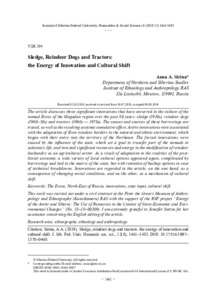Sledge, Reindeer Dogs and Tractors: the Energy of Innovation and Cultural Shift
Скачать файл:
URI (для ссылок/цитирований):
https://elib.sfu-kras.ru/handle/2311/112622Автор:
Sirina, Anna A.
Сирина, А. А.
Дата:
2019-08Журнал:
Журнал Сибирского федерального университета. Гуманитарные науки. Journal of Siberian Federal University. Humanities & Social Sciences;2019 12 (8)Аннотация:
The article discusses three significant innovations that have occurred in the culture of the
nomad Evens of the Magadan region over the past 80 years: sledge (1930s), reindeer dogs
(1940–50s) and tractors (1960s — 1970s). The causes and sources of these borrowings are
traced, as well as the resulting systemic cumulative effect. Active innovations were associated
with the adaptation of Even reindeer herders to the natural and ethnic environment, which
began with their entry into the territory of the Northeast. The forced innovations were
caused by the influence of the state, which set a goal to transfer part of the nomads to
sedentary life, and invested significant resources and energy in the modification of reindeer
husbandry as an agricultural sector. As a result of adaptation to the realities of the post-Soviet
economy, a wide variety of local cultural options appeared again, complicated by
borrowings and tied to the matrix of the state, but with retention of backup options in case
of technical breakdowns. Innovations are regarded in the article, on the one hand, as a
consequence of changing social conditions, and on the other, as a mechanism of cultural
shift В статье рассматриваются три знаковых инновации, которые появились в культуре
неоседлых эвенов Магаданской области за последние 80 лет: нарты (1930-е годы),
оленегонные собаки (1940–50-е годы) и трактора (1960‑1970-е годы). Прослеживаются
причины и истоки этих заимствований, а также вызванный ими системный
кумулятивный эффект. Активные инновации были связаны с адаптацией эвенов-оленеводов
к природной и этнической среде, начавшиеся с их выхода на территорию
Северо-Востока.
Форсированные инновации были вызваны влиянием государства,
поставившего целью перевести часть кочевников на оседлость, а также вкладывавшего
значительные ресурсы и энергию в модификацию оленеводства как отрасли сельского хозяйства. В результате адаптации к реалиям постсоветской экономики вновь
появилось большое разнообразие локальных вариантов культуры, усложненной
заимствованиями и привязанной к матрице государства, однако сохраняющей
запасные варианты на случай отказа технологических устройств. Инновации
рассматриваются в статье, с одной стороны, как следствие процессов пересечения
разных темпоральных режимов в результате этносоциальных контактов и влияния
государства, а с другой, как механизм культурного сдвига

